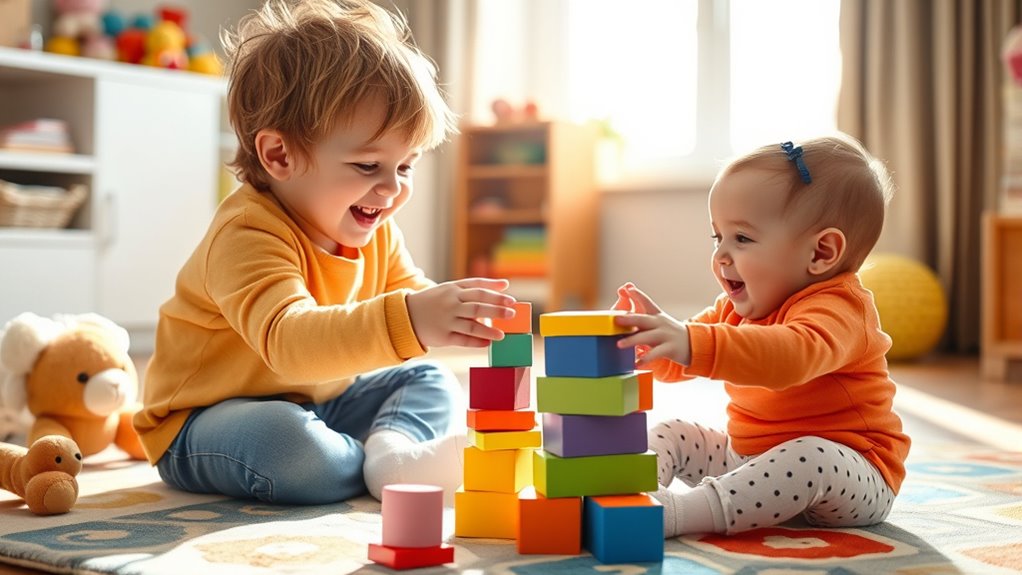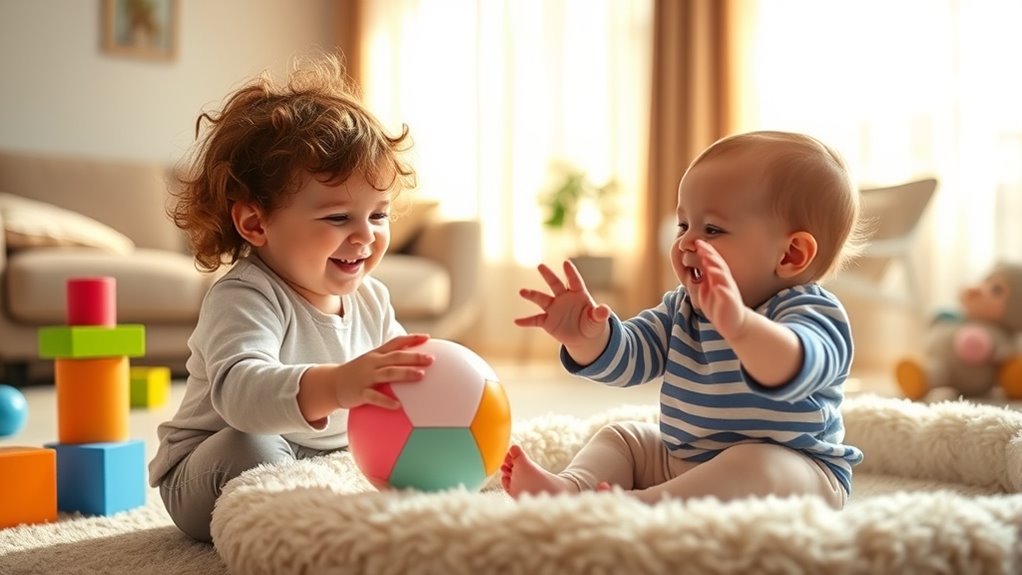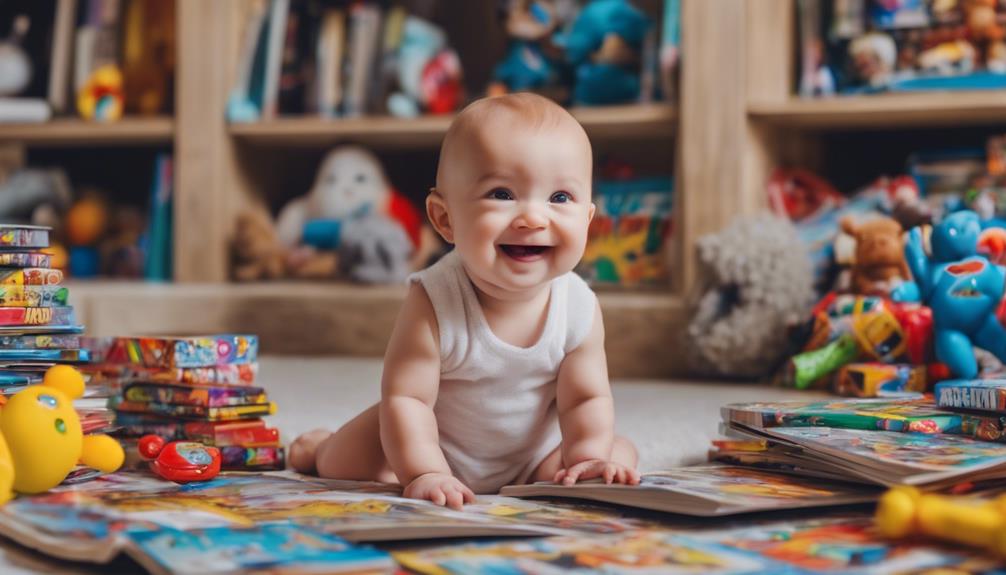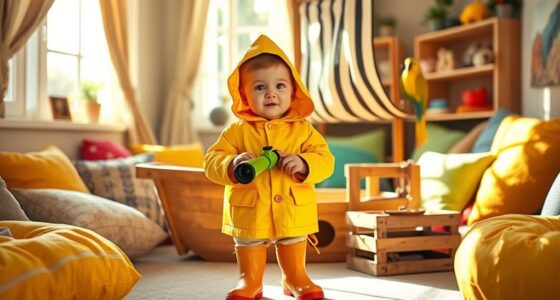You can create fun, engaging activities for a toddler and baby by combining outdoor exploration, musical play, and simple games. Try setting up a musical parade outside with instruments like tambourines and drums, allowing both to enjoy sounds and rhythms together. Incorporate natural elements like collecting leaves or stones to encourage curiosity and physical activity. These shared experiences foster bonding, boost development, and keep everyone happy. Keep exploring for more tips to make your playtime even more special.
Key Takeaways
- Incorporate musical instruments like drums and tambourines for shared rhythm and sound exploration.
- Plan outdoor scavenger hunts for natural objects to encourage curiosity and teamwork.
- Play simple follow-the-leader or mimic movements to promote coordination and social interaction.
- Set up sensory stations with different textured materials for tactile exploration accessible to both ages.
- Engage in cooperative musical activities like a outdoor musical parade to foster bonding and creativity.

Playing together can be a wonderful way for a toddler and a baby to bond, even if they’re at different development stages. When you create opportunities for them to share experiences, you foster a sense of connection that lasts. One great way to do this is by introducing musical instruments into their playtime. Toddlers love to shake tambourines or tap on drums, and babies are often fascinated by the sounds coming from these instruments. You can sit together on the floor, passing around small instruments and encouraging them to explore the different noises they can make. This shared activity helps develop their sensory skills and introduces them to rhythm and sound in a fun, engaging way. Plus, it’s easy to adapt based on their abilities—your toddler can imitate rhythms, while your baby can simply enjoy the sounds. Regular exposure to these activities can also support their overall anti-aging effects, helping to keep their skin healthy and youthful as they grow. Outdoor adventures are another fantastic setting for mixed-age play. Whether it’s a walk in the park, a trip to the backyard, or a visit to a playground, outdoors provides endless opportunities for both of them to explore and have fun together. During these outings, you can set up simple games like a treasure hunt for natural objects—leaves, stones, or flowers—that both can collect. As you walk, point out birds, insects, and trees, turning the outing into an educational adventure. Your toddler can help identify and gather items, while your baby observes and learns from the sights and sounds around them. These outdoor experiences not only promote physical activity but also encourage curiosity and language development for both ages. Playing with musical instruments outside can add another layer of fun. Bring along a small drum or maracas, and let your toddler lead a little musical parade while your baby watches and listens. The outdoor environment amplifies their senses—birds chirping, wind rustling leaves, and the sounds of their own music create a lively, multi-sensory experience. This setting supports cooperative play, as they learn to share instruments and enjoy making music together. As they grow, these outdoor adventures and musical explorations serve as a foundation for teamwork, creativity, and bonding. They learn that playing isn’t just about the activity itself but about sharing joy and discovery with each other. By intentionally creating these moments, you nurture a close relationship that helps both your toddler and baby thrive emotionally and socially.
Frequently Asked Questions
How Can I Ensure Safety During Mixed-Age Play?
To guarantee safety during play, you should implement supervision strategies that keep a close eye on both your toddler and baby. Always stay nearby and intervene if play becomes too rough. Choose safe toy selection by avoiding small parts or sharp edges, and opt for age-appropriate toys. Regularly check toys for damage. By actively supervising and selecting safe toys, you create a secure environment where both children can enjoy playtime together.
What Are Some Quiet Games for Toddlers and Babies?
Imagine discovering peaceful moments your little ones can share. Quiet games like gentle story time captivate both your toddler and baby, fostering calm and connection. Soft music creates a soothing backdrop, encouraging relaxation and bonding. These activities keep everyone engaged without overstimulation. By choosing calm, interactive options, you guarantee your children enjoy peaceful, enriching moments together while developing their listening and language skills. The secret lies in gentle, shared experiences that nurture tranquility.
How Do I Encourage Sibling Bonding Through Play?
You can encourage sibling bonding through play by sharing storytelling sessions where both share ideas and listen actively. Engage them in collaborative art projects like drawing or coloring together, fostering teamwork. These activities promote communication and create positive memories. Keep the environment fun and supportive, encouraging both children to express themselves and enjoy each other’s company. This approach helps strengthen their relationship naturally through shared experiences and creativity.
What Toys Are Suitable for Both Babies and Toddlers?
Imagine you’re stepping into the time machine of parenting. For your little explorers, choose shared toys that are safe and engaging for both babies and toddlers. Look for age-appropriate options like soft blocks, stacking cups, or plush animals. These toys foster cooperation, curiosity, and bonding. Always supervise play, ensuring safety and fun. With the right shared toys, you create a world of discovery where both age groups thrive together.
How Can I Modify Games for Different Developmental Stages?
When modifying games for different developmental stages, you focus on meeting each child’s unique needs. Observe their developmental milestones, then adjust activities to be age-appropriate. For younger babies, simplify tasks and prioritize sensory exploration. For toddlers, introduce more complex challenges that promote motor skills and problem-solving. By tailoring activities, you guarantee both children stay engaged and benefit from the game, fostering growth at their individual stages.
Conclusion
Remember, “the whole is greater than the sum of its parts.” Playing together helps your toddler and baby build bonds, develop skills, and create lasting memories. Keep the games simple, fun, and inclusive, so everyone feels involved. By encouraging shared play, you’re nurturing a loving, cooperative relationship that grows stronger each day. So, embrace these moments—they’re precious and fleeting, and, as the saying goes, “Enjoy the little things, for one day you’ll look back and realize they were the big things.”










